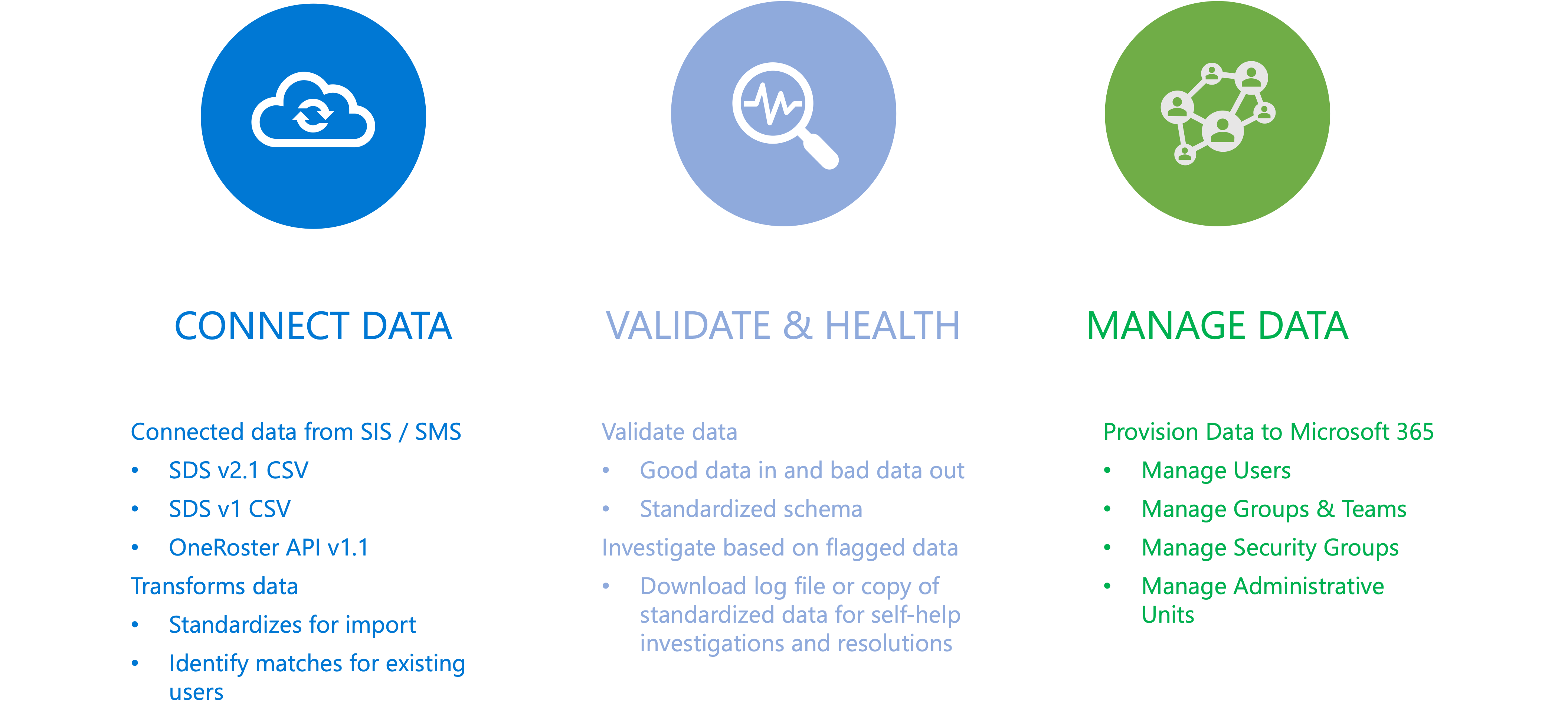Microsoft School Data Sync
School Data Sync
Important
Customers will be transitioning to the new School Data Sync (SDS) experience for their upcoming Back to School, starting with the Northern Hemisphere August 2024 and the Southern Hemisphere January 2025.
Starting July 1, customers will not be able to create new, renew, or extend School Data Sync (Classic) Sync Profiles. Existing (Classic) Sync Profiles with expiration dates after December 31, 2024 will stop running on December 31, 2024.
The School Data Sync (Classic) experience will be sunset December 31, 2024. Begin planning for your transition from SDS (Classic).
School Data Sync (SDS) is a free service for Education that helps to automate the process of synchronizing user and roster data from Student Information or Management Systems with Microsoft 365. SDS is a tool that helps you manage your educational organization, users, classes, and roles. SDS syncs your data with Microsoft Entra ID and Microsoft 365, so you can use Microsoft Teams, Intune for Education, Exchange Online, SharePoint Online, OneNote Class notebooks, and enable third-party apps with Single Sign On integration. SDS helps make learning more engaging and efficient.
School Data Sync models the best practices of the Education Customer Success Team that has helped institutions successfully set up and use School Data Sync to empower Microsoft 365 experiences globally.
The onboarding experience is broken down into connect data and managing data to enable scenarios to improve learning outcomes.
We believe that applying these best practices, to improve the IT administrator’s experience for onboarding and monitoring, along with better understanding of the health of their data, provides more time for administrators to help educators focus on innovations to improve learning outcomes.
High level overview
We recommend reading SDS Overview for a deeper understanding of the core concepts of SDS.
Connect Data: SDS allows you to connect data, stored in your SIS/SMS, by defining your source system, the format of the incoming data, your user identity matching rules, and define your sync end date for your academic session.
- Data Ingestion with SDS v2.1 CSV
- Data Ingestion with OneRoster API
- Data Ingestion with SDS v1 CSV
- Not all fields are supported to bring data into the new SDS experience based on the SDS v1 CSV format. You find them noted in SDS v1 CSV File Format under column Required? as data not supported.
- Also, Grade values and Course Subject values passed must align to their corresponding List of Values (ENUM) codes. If needed, utilize Managing List of Values to expand Grade values and Course Subject to support code values not supported by default.
Manage Data: SDS provides dynamic provisioning and roster updates for virtual classrooms in Microsoft 365, to assist with simplified deployment and adoption of Microsoft 365 Group-enabled apps like Teams, SharePoint, Exchange, and OneNote Class Notebooks. SDS also performs provisioning of education institutions, users and groups for IT to assist with simplified Microsoft 365 identity management, app management, and device management. SDS also provides the option to store SIS/SMS values it syncs within Microsoft Entra ID. Provisioning to Microsoft Entra ID can also make roster information available to third party applications through the Education APIs (Application Programming Interfaces) and Microsoft Graph.
- Users: Allows you to automate management of your Microsoft 365 users.
- Class groups: Provides a space for users to connect with each other, communicate, and collaborate across various Microsoft 365 applications including Teams.
- Security groups: Provides a grouping construct for use within various identity management, application management, and device management scenarios in Microsoft 365.
- Administrative units: Provides a grouping construct for delegated IT administration and scoped role assignments. Scoped role assignments allow admins to manage a subset of the broader Microsoft 365 directory.
Validate and Health: SDS passes the data through data matching and validation rules to help safeguard good required and optional data only going into the SDS cache. Data that doesn't pass validation is identified as errors or warnings and isn't sent to the SDS cache.
SDS customer and partner benefits
IT administrators
- Save time by automating creation of online classrooms and users.
- Simplify security with a single, compliant source for user profiles and rosters that all classroom applications can use.
- SDS mirrors data from the Student Information System (SIS) into Microsoft 365 and Microsoft Entra ID, automates provisioning of online classrooms and educator and student accounts.
- SDS enables any classroom application to access encrypted cloud-based data through the no-cost API.
Educators
- Spend less time creating classes, managing rosters, and troubleshooting access to apps and shared online resources.
- Enable the easy creation of Teams for Education, OneNote Class Notebooks, Microsoft 365 groups for online messaging, file sharing, and collaboration.
- SDS integrates with many other education offerings and apps SIS vendors.
SIS/SMS vendors
- Support and connect to more apps through a single, no-cost API.
- Quickly and easily provide app partners with access to student data, allowing them to focus on differentiation, not app integration.
Application (App) partners
- Provide customers with a single sign-on to their applications that “just works.”
- SDS enables app partners to spend less time integrating with different SIS systems, and more time creating personalized experiences for teachers and students.
- No-cost API works with multiple SIS providers, operating systems, and devices.
System integrators
- Save educational institutions time by integrating their SIS with Microsoft 365.
- Build export/import processes for each customer or write cloud connectors that can scale across multiple schools, entities, and departments helping them keep their user profiles and class rosters up to date.
